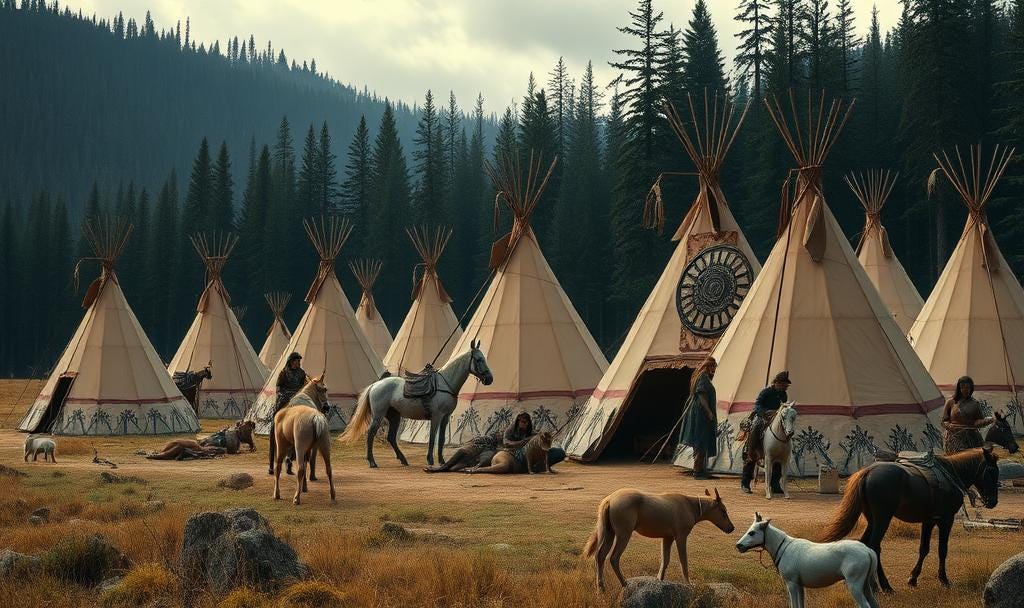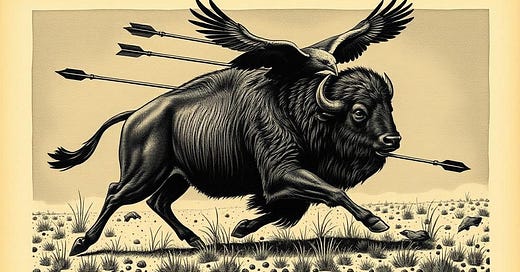Quaker Policy Backfires
Quanah battles Colonel Mackenzie in 1871
‘Whenever I charge, nothing stops me.
If anything gets in my way, I run right over it.’
- Blackfoot Heavy-Set’s war song given by the buffalo.
‘General’ (Colonel) Ranald Slidell Mackenzie
Mackenzie ultimately defeats the Comanche, but the man falls to pieces shortly thereafter. Mackenzie’s experiences in the American Civil War gave him the capacity to destroy lives. After Mackenzie’s paymasters deployed this capability successfully against the Comanche and Kiowas in the Red River War of 1874, Mackenzie broke. The realization that his success and prosperity was built on destroying the lives of people he had no quarrel with nor felt any particular standing strained Mackenzie deeply. Mackenzie fell in love with a woman named Mrs. Sharp in 1882 but found the idea of building a humane life on the career of war too much to bear and shortly fell apart, like a cliff shattered by thunder.
Mackenzie and Quanah became friends after the war, reportedly Mackenzie gave Quanah lessons in etiquette - Quanah was motivated to fit into the new life. By all accounts Mackenzie was capable, honorable and respectable, not given to vice - which may have what led to his lethally intractable despair. Mackenzie was a tragic character right out of ‘War and Peace’, or rather an example of the tensions of divergent reality and the torment that inhabiting both worlds inflicts upon honorable men that ‘War and Peace’ describes.
This is a story from several years before Mackenzie broke. Before the Red River war of 1874 - the final defeat of the Comanche. When Mackenzie cut his teeth learning how to fight in the plains locking horns with Quanah and the Kwahadi Comanche band on their home turf when they were both at the top of their game. There is a rough saying in Texas, you have to take a butt-whipping before you learn how to give one. Here Mackenzie rakes a savage burner learner lesson.
Stage Set
The trouble began on May 17, 1871 on a road stretching between Fort Still, TX and Jacksboro, TX, south of the Red River Oklahoma border.
[1] A band of Kiowa, led by Satanta, Eagle Heart, Big Tree and Sa-tank, attack a mule team. They kill the driver, Henry Warren, and six others. One man is tied to a wagon wheel and roasted by flame.
[2] Five men from the party run to Jacksboro. General Tecumseh Sherman happens to be there with a small escort. Earlier that day General Sherman had passed by the spot of the wagon attack. Shocked, Sherman orders a dispatch to find arrest the attackers.
[3] Satanta, Eagle Tree, Eagle Heart and Sa-Tank are brought in. Several are arrested. Sa-Tank fought his captors and was killed (allegedly) en route. Eagle Heart would escape. The men were ultimately given reprieve.

Frustrated with the lack of accountability for the perpetrators of the wagon team, the Quaker Agent Tatum writes Colonel Grierson asking for General Mackenzie to come attack the Comanche and bring them to heel at the reservation. Grierson complies, Mackenzie is tasked.
[1] Aug. 19th. Mackenzi leads 600 men out of Fort Richardson toward the Llano Estacado. The men learn the ropes of the staked plains, then return to Camp Cooper to regroup.
[2] In October Mackenzie leads the men again from Camp Cooper. The Comanche stampede 70 of their horses at their camp on the Brazos River.
[3] Undeterred by the setback of their horses, Mackenzie leads the men into the Llano Estacado again. They encounter Quanah Parker and the Kwahedi at Blanco Canyon. the Comanche fight Mackenzie’s soldiers and scouts to cover the retreat of the women and old men with their pack animals and lodging.
[4] A norther (heavy storm full of rain, sleet, snow and lightning in some combination) puts Mackenzie off from pursuing the natives further.
Though this engagement seemed a military failure, Mackenzie learned many lessons he would later put to use about the Llano Estacado and Comanche war tactics. Later Mackenzie would be ready and prevent a similar attempt at stampede.
Historical Prompts

One dandy warrior had a shield decorated with a bear's claw, mule's tail and scalp, indicating he was a great hunter, horse thief and warrior. - Richardson. Pg. 109

This is how a newspaper The Herald reported its description of a Comanche chief named Black Horse - qualifying their reporting that Black Horse was ‘the most blood-thirsty scoundrel on the plains.’
The so-called war culture of the plains was greatly enhanced and spurred on by the illegal encroachment of Americans on their lands. Settlers took the best lands first - as the native ways of lives were degraded through the loss of the best land, the destruction of their herds, mass death by disease, and military force - more and more they needed to raid to sustain their livelihoods as buffalo disappeared under the sharp gun situation.
The insistence of the government on tribes west of the 98th meridian to take up farming was ridiculous - the kind of non-sensical directive that came with a cynical aloofness there was no real answer. The climate and soil were not suitable for farming, nor could raiding continue, nor would Americans stop encroaching.
Description of tribal context around Comanche by the 1800s. The Kiowa were their allies after 1790. The rest were usually in play as war parties.

References
Richardson, Rupert Norval. Comanche Barrier to South Plains Settlement. 1 Mar. 1993.
Gwynne, S C. Empire of the Summer Moon : [Quanah Parker and the Rise and Fall of the Comanches, the Most Powerful Indian Tribe in American History]. London, Constable, 2011.
official reports of the committee of investigation sent in 1873 by the mexican government to the frontier of texas








